

ISSN 1004-5759 CN 62-1105/S


草业学报 ›› 2024, Vol. 33 ›› Issue (10): 1-13.DOI: 10.11686/cyxb2023446
• 研究论文 •
收稿日期:2023-11-21
修回日期:2024-01-12
出版日期:2024-10-20
发布日期:2024-07-15
通讯作者:
周正朝
作者简介:Corresponding author. E-mail: zczhou@snnu.edu.cn基金资助:
Fang LIU( ), Pei-pei WANG, Yu-ying CAO, Jun-e LIU, Zheng-chao ZHOU(
), Pei-pei WANG, Yu-ying CAO, Jun-e LIU, Zheng-chao ZHOU( )
)
Received:2023-11-21
Revised:2024-01-12
Online:2024-10-20
Published:2024-07-15
Contact:
Zheng-chao ZHOU
摘要:
为控制黄土高原严重的水土流失,我国实施了大规模的植被恢复,生态环境得到改善。阐明植被恢复过程中不同根系类型对土壤性质的影响差异,有利于完善黄土高原植被恢复优选模式的系统性研究,为黄土高原后续生态恢复提供参考。本研究选取黄土高原自然恢复优势种长芒草(须根系)和铁杆蒿(直根系)为研究对象,以退耕一年的裸地为对照,测定根系特征与土壤理化性质,分析不同直径下根系分布规律及其与土壤理化性质的关系。结果表明:1)长芒草和铁杆蒿根系特征差异显著,须根系长芒草极细根(直径,D<0.5 mm)根长密度(RLD)和根表面积密度(RSAD)占比较高,分别为94.73%和90.20%。直根系铁杆蒿主根优势明显,表现出较高的根质量密度(RMD)、平均直径(RD)和根体积密度(RVD)。其中,铁杆蒿粗根RLD(16.28%)和RSAD(32.85%)的占比明显高于长芒草。2)与裸地相比,长芒草与铁杆蒿显著改善土壤结构,提高土壤稳定性。长芒草与铁杆蒿根系主要聚集在0~20 cm土层,对表层土壤的理化性质影响最大。其中,铁杆蒿群落土壤团聚体稳定性和土壤持水性最高,土壤团聚体平均重量直径(2.04 mm)、毛管持水量(24.69%)及饱和含水量(34.93%)分别是裸地的4.33、1.36和1.31倍。长芒草群落土壤有机质含量(7.23 g·kg-1)最高。3)植物根系特征显著影响土壤性质,细根RLD与RSAD对土壤理化性质的影响最显著。细根RLD和RSAD与土壤容重显著负相关(P<0.05),与土壤孔隙度显著正相关(P<0.05),极细根(D<0.5 mm)与有机质含量极显著正相关(P<0.01)。主成分分析结果显示,长芒草与铁杆蒿改善土壤性质的差异主要体现在土壤团聚体平均重量直径(MWD)、有机质含量(SOM)和土壤含水量(SWC)。
刘芳, 王佩佩, 曹玉莹, 刘俊娥, 周正朝. 黄土高原典型草本植物根系分布特征及其对土壤理化性质的影响研究[J]. 草业学报, 2024, 33(10): 1-13.
Fang LIU, Pei-pei WANG, Yu-ying CAO, Jun-e LIU, Zheng-chao ZHOU. Root distribution characteristics of typical herbaceous plants and their effects on soil physicochemical properties on the Loess Plateau[J]. Acta Prataculturae Sinica, 2024, 33(10): 1-13.
| 坡点Slope code | 经度Longitude (E) | 纬度Latitude (N) | 海拔Elevation (m) | 坡度Slope ( | 砂粒Sand (%) | 粉粒Silt (%) | 黏粒Clay (%) |
|---|---|---|---|---|---|---|---|
| 长芒草S. bungeana-1 | 110 | 38 | 1221.60 | 13 | 59.00 | 33.93 | 4.08 |
| 长芒草S. bungeana-2 | 110 | 38 | 1224.12 | 15 | 56.72 | 35.34 | 4.94 |
| 长芒草S. bungeana-3 | 110 | 38 | 1218.77 | 15 | 54.27 | 40.49 | 5.25 |
| 铁杆蒿A. gmelinii-1 | 110 | 38 | 1228.15 | 15 | 58.18 | 36.67 | 5.15 |
| 铁杆蒿A. gmelinii-2 | 110 | 38 | 1209.74 | 13 | 52.75 | 41.57 | 5.69 |
| 铁杆蒿A.gmelinii-3 | 110 | 38 | 1205.14 | 16 | 51.62 | 43.70 | 4.67 |
| 裸地CK | 110 | 38 | 1131.42 | 16 | 70.12 | 25.90 | 3.98 |
表1 各样地基本信息
Table 1 Basic situation of each sample
| 坡点Slope code | 经度Longitude (E) | 纬度Latitude (N) | 海拔Elevation (m) | 坡度Slope ( | 砂粒Sand (%) | 粉粒Silt (%) | 黏粒Clay (%) |
|---|---|---|---|---|---|---|---|
| 长芒草S. bungeana-1 | 110 | 38 | 1221.60 | 13 | 59.00 | 33.93 | 4.08 |
| 长芒草S. bungeana-2 | 110 | 38 | 1224.12 | 15 | 56.72 | 35.34 | 4.94 |
| 长芒草S. bungeana-3 | 110 | 38 | 1218.77 | 15 | 54.27 | 40.49 | 5.25 |
| 铁杆蒿A. gmelinii-1 | 110 | 38 | 1228.15 | 15 | 58.18 | 36.67 | 5.15 |
| 铁杆蒿A. gmelinii-2 | 110 | 38 | 1209.74 | 13 | 52.75 | 41.57 | 5.69 |
| 铁杆蒿A.gmelinii-3 | 110 | 38 | 1205.14 | 16 | 51.62 | 43.70 | 4.67 |
| 裸地CK | 110 | 38 | 1131.42 | 16 | 70.12 | 25.90 | 3.98 |
植物类型 Plant type | 根质量密度 Root mass density RMD (mg·cm-3) | 平均直径 Root diameter RD (mm) | 根长密度 Root length density RLD (cm·cm-3) | 根表面积密度 Root surface area density RSAD (cm2·cm-3) | 根体积密度 Root volume density RVD (102·cm3·cm-3) |
|---|---|---|---|---|---|
| 长芒草(S) | 0.53±0.08* | 0.26±0.01* | 1.15±0.16* | 0.10±0.01* | 0.09±0.01 |
| 铁杆蒿(A) | 3.10±0.42* | 0.43±0.03* | 0.66±0.07* | 0.06±0.01* | 0.13±0.04 |
表2 不同植物群落的根系特征
Table 2 Root characteristics of different plant communities
植物类型 Plant type | 根质量密度 Root mass density RMD (mg·cm-3) | 平均直径 Root diameter RD (mm) | 根长密度 Root length density RLD (cm·cm-3) | 根表面积密度 Root surface area density RSAD (cm2·cm-3) | 根体积密度 Root volume density RVD (102·cm3·cm-3) |
|---|---|---|---|---|---|
| 长芒草(S) | 0.53±0.08* | 0.26±0.01* | 1.15±0.16* | 0.10±0.01* | 0.09±0.01 |
| 铁杆蒿(A) | 3.10±0.42* | 0.43±0.03* | 0.66±0.07* | 0.06±0.01* | 0.13±0.04 |
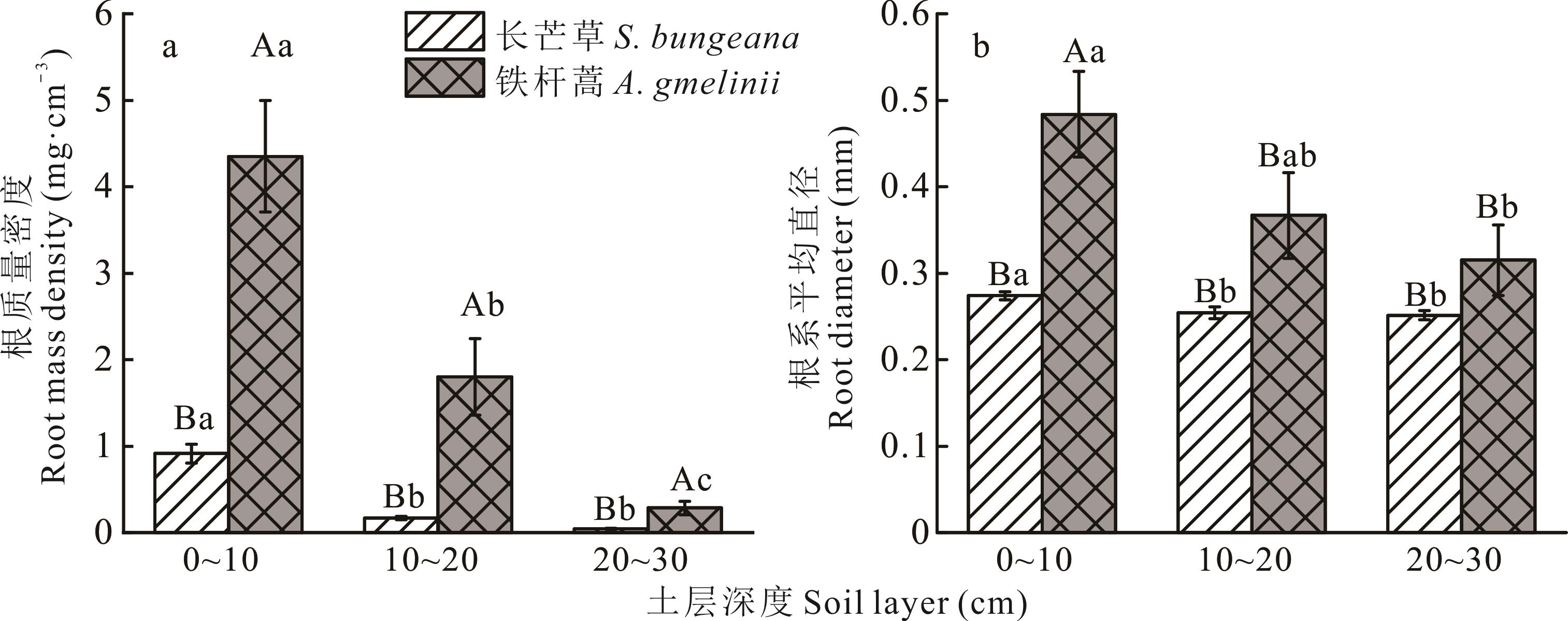
图2 不同植物群落根质量密度与平均直径不同大写字母表示不同植物群落差异显著(P<0.05),不同小写字母表示不同土层差异显著(P<0.05)。下同。Different capital letters indicate significant (P<0.05) differences between plant communities, and different lowercase letters indicate significant (P<0.05) differences among soil layers. The same below.
Fig.2 Root mass density and mean diameter of different plant communities
植物类型 Plant type | 径级 Diameter (D, mm) | 根长密度Root length density (cm·cm-3) | 占根系总根长百分比 Percentage of total root length (%) | ||
|---|---|---|---|---|---|
| 0~10 cm | 10~20 cm | 20~30 cm | |||
长芒草 S. bungeana | 极细根(V) (0≤D<0.5) | 1.629±0.884a | 0.548±0.291a | 0.193±0.100a | 94.73 |
| 细根(F) (0.5≤D<2.0) | 0.107±0.087b | 0.012±0.006b | 0.003±0.002b | 4.76 | |
| 粗根(C) (D≥2.0) | 0.013±0.003b | - | - | 0.51 | |
铁杆蒿 A. gmelinii | 极细根(V) (0≤D<0.5) | 0.644±0.313a | 0.363±0.164a | 0.084±0.052a | 71.26 |
| 细根(F) (0.5≤D<2.0) | 0.129±0.088b | 0.059±0.015b | 0.011±0.002b | 12.46 | |
| 粗根(C) (D≥2.0) | 0.186±0.065b | 0.060±0.024b | 0.017±0.004b | 16.28 | |
表3 不同植物群落不同直径不同土层深度的根长密度
Table 3 Root length density of different plant communities with different diameters and soil depths
植物类型 Plant type | 径级 Diameter (D, mm) | 根长密度Root length density (cm·cm-3) | 占根系总根长百分比 Percentage of total root length (%) | ||
|---|---|---|---|---|---|
| 0~10 cm | 10~20 cm | 20~30 cm | |||
长芒草 S. bungeana | 极细根(V) (0≤D<0.5) | 1.629±0.884a | 0.548±0.291a | 0.193±0.100a | 94.73 |
| 细根(F) (0.5≤D<2.0) | 0.107±0.087b | 0.012±0.006b | 0.003±0.002b | 4.76 | |
| 粗根(C) (D≥2.0) | 0.013±0.003b | - | - | 0.51 | |
铁杆蒿 A. gmelinii | 极细根(V) (0≤D<0.5) | 0.644±0.313a | 0.363±0.164a | 0.084±0.052a | 71.26 |
| 细根(F) (0.5≤D<2.0) | 0.129±0.088b | 0.059±0.015b | 0.011±0.002b | 12.46 | |
| 粗根(C) (D≥2.0) | 0.186±0.065b | 0.060±0.024b | 0.017±0.004b | 16.28 | |
植物类型 Plant type | 径级 Diameter (D, mm) | 根表面积密度Root surface area density (cm2·cm-3) | 占根系总根表面积百分比 Percentage of total root surface area (%) | ||
|---|---|---|---|---|---|
| 0~10 cm | 10~20 cm | 20~30 cm | |||
长芒草 S. bungeana | 极细根(V) (0≤D<0.5) | 0.141±0.074a | 0.042±0.020a | 0.015±0.007a | 90.20 |
| 细根(F) (0.5≤D<2.0) | 0.019±0.016b | 0.002±0.001b | 0.001±0.000b | 9.54 | |
| 粗根(C) (D≥2.0) | 0.011±0.001b | - | - | 0.26 | |
铁杆蒿 A. gmelinii | 极细根(V) (0≤D<0.5) | 0.044±0.025a | 0.027±0.011a | 0.006±0.004a | 45.42 |
| 细根(F) (0.5≤D<2.0) | 0.025±0.016a | 0.012±0.003b | 0.002±0.002b | 21.73 | |
| 粗根(C) (D≥2.0) | 0.043±0.013a | 0.021±0.007ab | 0.003±0.001b | 32.85 | |
表4 不同植物群落不同直径不同土层深度的根表面积密度
Table 4 Root surface area density of different plant communities with different diameters and soil depths
植物类型 Plant type | 径级 Diameter (D, mm) | 根表面积密度Root surface area density (cm2·cm-3) | 占根系总根表面积百分比 Percentage of total root surface area (%) | ||
|---|---|---|---|---|---|
| 0~10 cm | 10~20 cm | 20~30 cm | |||
长芒草 S. bungeana | 极细根(V) (0≤D<0.5) | 0.141±0.074a | 0.042±0.020a | 0.015±0.007a | 90.20 |
| 细根(F) (0.5≤D<2.0) | 0.019±0.016b | 0.002±0.001b | 0.001±0.000b | 9.54 | |
| 粗根(C) (D≥2.0) | 0.011±0.001b | - | - | 0.26 | |
铁杆蒿 A. gmelinii | 极细根(V) (0≤D<0.5) | 0.044±0.025a | 0.027±0.011a | 0.006±0.004a | 45.42 |
| 细根(F) (0.5≤D<2.0) | 0.025±0.016a | 0.012±0.003b | 0.002±0.002b | 21.73 | |
| 粗根(C) (D≥2.0) | 0.043±0.013a | 0.021±0.007ab | 0.003±0.001b | 32.85 | |
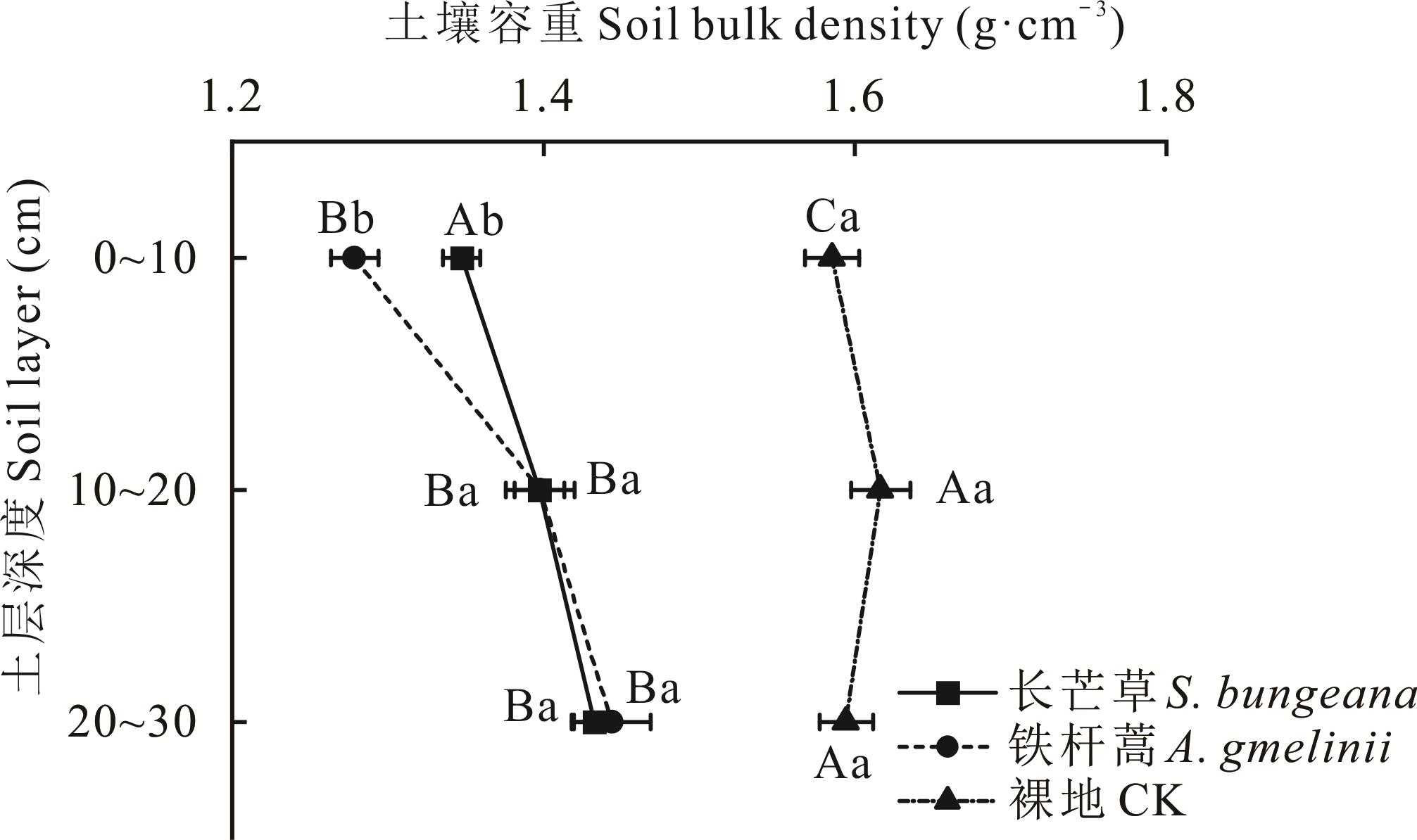
图3 不同植物群落的土壤容重不同大写字母表示不同植物群落间差异显著(P<0.05),不同小写字母表示不同土层间差异显著(P<0.05)。Different capital letters indicate significant (P<0.05) differences among plant communities, and different lowercase letters indicate significant (P<0.05) differences among soil layers.
Fig.3 Soil bulk density of different plant communities
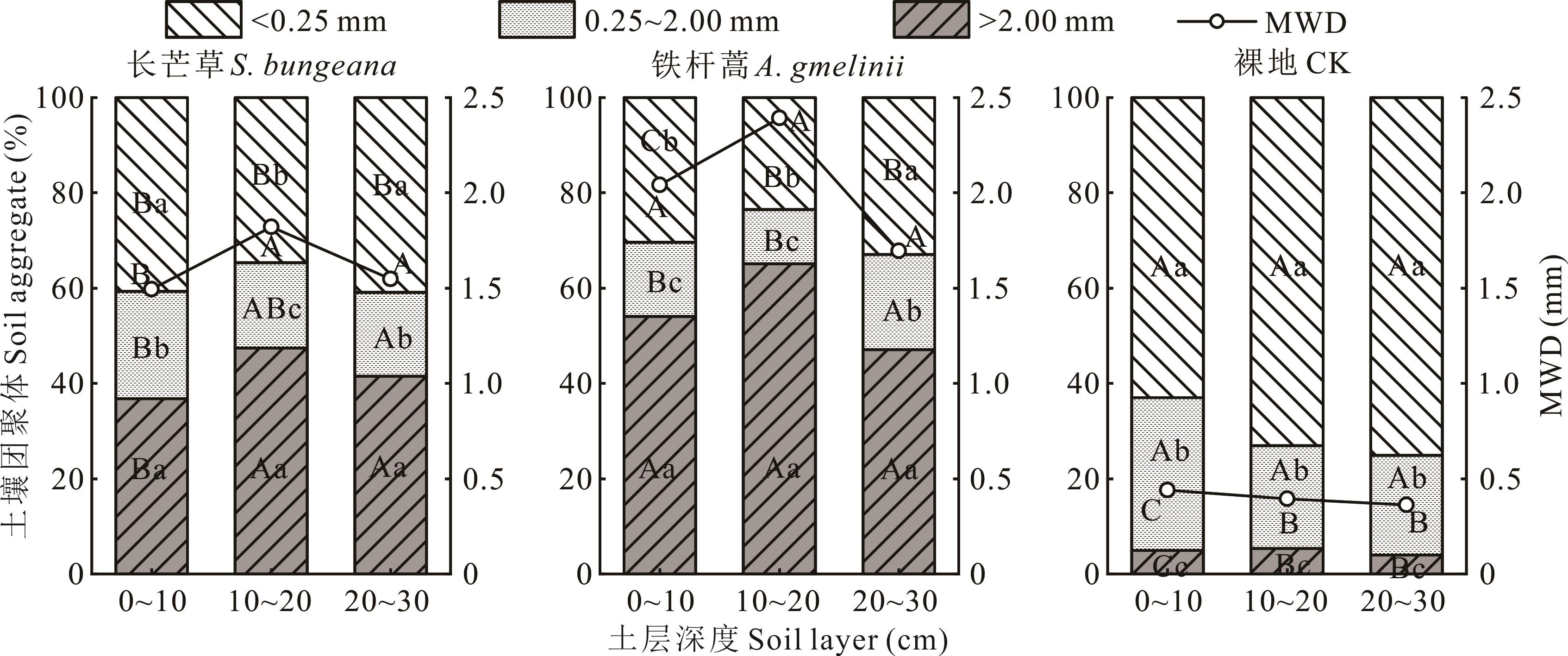
图5 不同植物群落的土壤团聚体不同大写字母表示同一粒径不同样地差异显著(P<0.05),不同小写字母表示同一样地不同粒径差异显著(P<0.05)。Different capital letters indicate significant (P<0.05) differences among different samples of the same size, and different lowercase letters indicate significant (P<0.05) differences among different size of the same sample. MWD: 平均重量直径 Mean weight diameter.
Fig.5 Soil aggregates of different plant communities
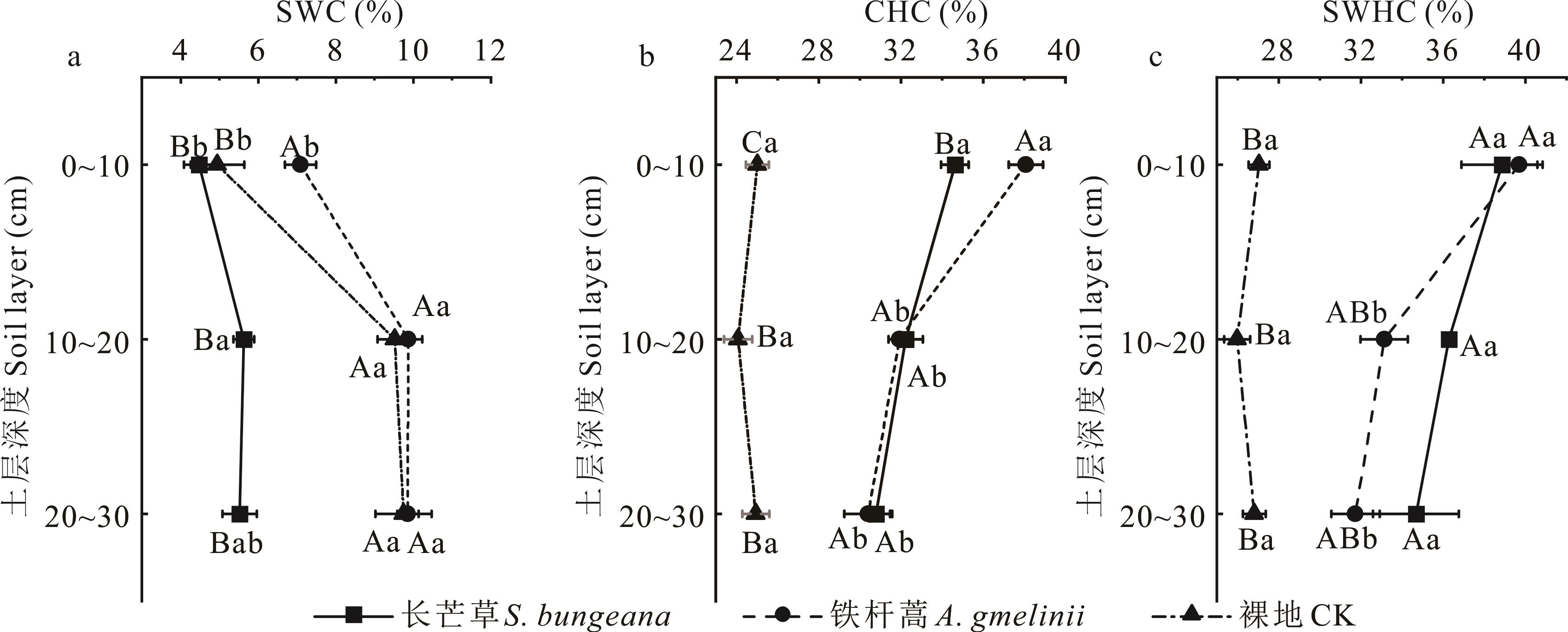
图6 不同植物群落的持水特征SWC: 土壤含水量Soil water content; CHC: 毛管持水量Capillary water holding content; SWHC: 饱和持水量Saturated water holding content. 不同大写字母表示不同植物群落间差异显著(P<0.05),不同小写字母表示不同土层间差异显著(P<0.05)。Different capital letters indicate significant (P<0.05) differences among plant communities, and different lowercase letters indicate significant (P<0.05) differences among soil layers.
Fig.6 Water retention characteristics of different plant communities
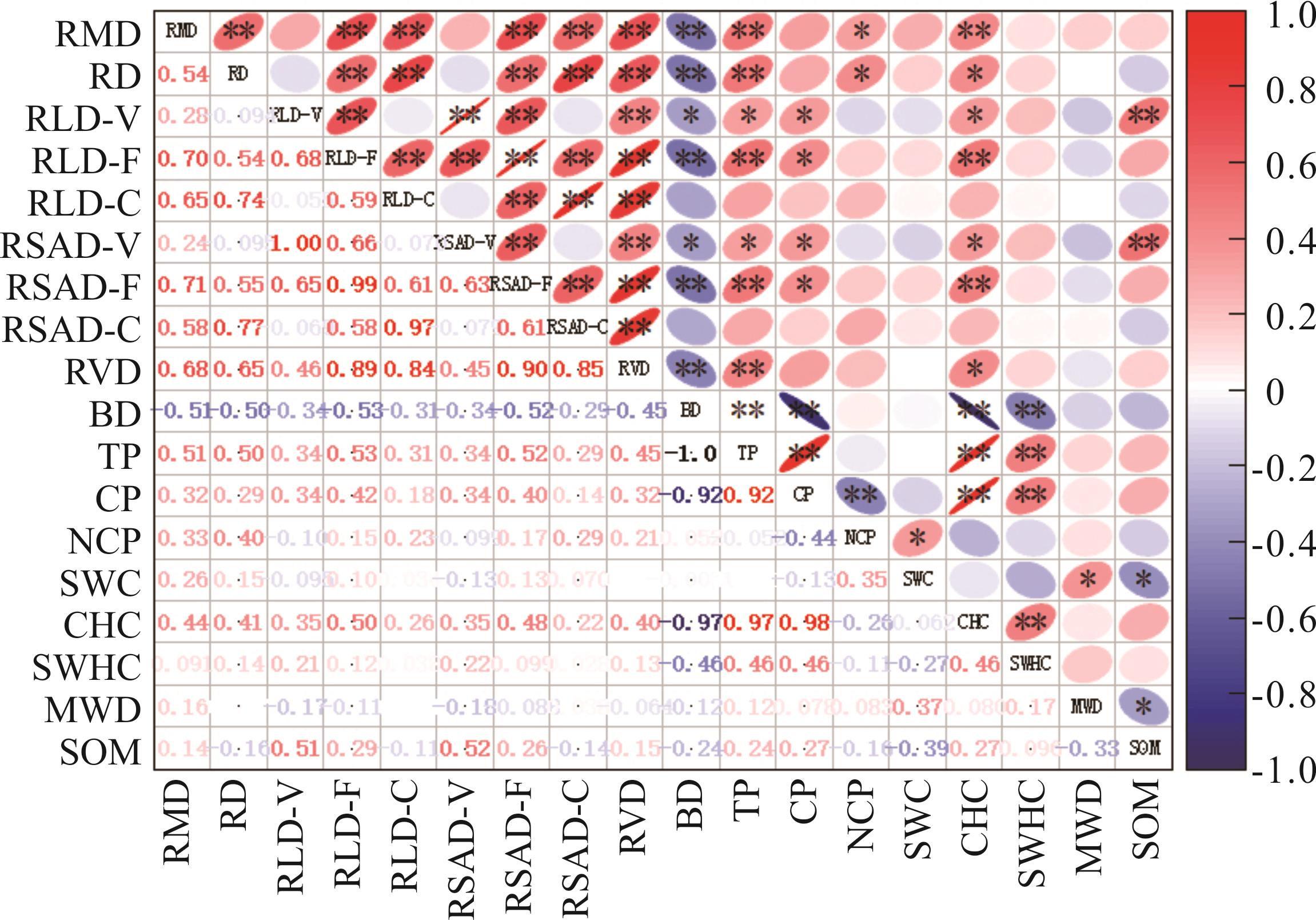
图8 根系参数与土壤性质相关关系分析**:P<0.01;*:P<0.05;RMD:根质量密度Root mass density;RD:根系直径Root diameter;RLD-V:极细根根长密度Very fine root’s root length density;RLD-F:细根根长密度Fine root’s root length density;RLD-C:粗根根长密度Coarse root’s root length density;RSAD-V:极细根根表面积密度Very fine root’s root surface area density;RSAD-F:细根根表面积密度Fine root’s root surface area density;RSAD-C:粗根根表面积密度Coarse root’s root surface area density;RVD:根体积密度Root volume density;BD:土壤容重Bulk density;TP:总孔隙度Total porosity;CP:毛管孔隙度Capillary porosity;NCP:非毛管孔隙度Non-capillary porosity;SWC:土壤含水量Soil water content;CHC:毛管持水量Capillary water holding content;SWHC:饱和含水量Saturated water holding content;MWD:平均重量直径Mean weight diameter;SOM:土壤有机质含量Soil organic matter content. 下同 The same below.
Fig.8 Analysis of the correlations between root morphological parameters and soil physicochemical properties
| 指标Index | PC1 | PC2 |
|---|---|---|
| 土壤容重Bulk density, BD | -0.994 | 0.032 |
| 土壤总孔隙度Total porosity, TP | 0.994 | -0.032 |
| 毛管持水量Capillary water holding content, CHC | 0.980 | -0.059 |
| 毛管孔隙度Capillary porosity, CP | 0.931 | -0.044 |
| 饱和持水量Saturated water holding content, SWHC | 0.510 | 0.152 |
| 平均重量直径Mean weight diameter, MWD | 0.163 | 0.829 |
| 土壤有机质含量Soil organic matter, SOM | 0.260 | -0.758 |
| 非毛管孔隙度Non-capillary porosity, NCP | -0.101 | 0.039 |
| 土壤含水量Soil water content, SWC | 0.029 | 0.531 |
| 特征值Eigenvalue | 4.321 | 1.836 |
| 方差贡献率Variance contribution ratio (%) | 48.02 | 20.40 |
| 累计方差贡献率Cumulative variance contribution ratio (%) | 48.02 | 68.42 |
表5 土壤性质主成分方差贡献率和载荷矩阵
Table 5 Principal component variance contribution rate and load matrix of soil properties
| 指标Index | PC1 | PC2 |
|---|---|---|
| 土壤容重Bulk density, BD | -0.994 | 0.032 |
| 土壤总孔隙度Total porosity, TP | 0.994 | -0.032 |
| 毛管持水量Capillary water holding content, CHC | 0.980 | -0.059 |
| 毛管孔隙度Capillary porosity, CP | 0.931 | -0.044 |
| 饱和持水量Saturated water holding content, SWHC | 0.510 | 0.152 |
| 平均重量直径Mean weight diameter, MWD | 0.163 | 0.829 |
| 土壤有机质含量Soil organic matter, SOM | 0.260 | -0.758 |
| 非毛管孔隙度Non-capillary porosity, NCP | -0.101 | 0.039 |
| 土壤含水量Soil water content, SWC | 0.029 | 0.531 |
| 特征值Eigenvalue | 4.321 | 1.836 |
| 方差贡献率Variance contribution ratio (%) | 48.02 | 20.40 |
| 累计方差贡献率Cumulative variance contribution ratio (%) | 48.02 | 68.42 |
| 1 | Tan X J. Effects of grassland restoration on soil physical properties in the Loess Plateau. Yangling: Northwest A&F University, 2019. |
| 谭学进. 黄土高原草地恢复对土壤物理性质的影响. 杨凌: 西北农林科技大学, 2019. | |
| 2 | Yang Z, Jin H, Wang G. An assessment of restoration success to forests planted for ecosystem restoration in Loess Plateau, Northwestern China. Environmental Monitoring and Assessment, 2010, 164: 357-368. |
| 3 | Cao L, Zhang K, Zhang W. Detachment of road surface soil by flowing water. Catena, 2009, 76(2): 155-162. |
| 4 | Cao J, Tian H, Adamowski J F, et al. Influences of afforestation policies on soil moisture content in China’s arid and semi-arid regions. Land Use Policy, 2018, 75: 449-458. |
| 5 | Yu M Z, Zhang L L, Xu X X, et al. Impact of land-use changes on soil hydraulic properties of Calcaric Regosols on the Loess Plateau, NW China. Journal of Plant Nutrition and Soil Science, 2015, 178(3): 486-498. |
| 6 | Wu G L, Zhang Z N, Wang D, et al. Interactions of soil water content heterogeneity and species diversity patterns in semi-arid steppes on the Loess Plateau of China. Journal of Hydrology, 2014, 519: 1362-1367. |
| 7 | Shi Z H, Fang N F, Wu F Z, et al. Soil erosion processes and sediment sorting associated with transport mechanisms on steep slopes. Journal of Hydrology, 2012, 454: 123-130. |
| 8 | Huang Z, Liu Y F, Cui Z, et al. Natural grasslands maintain soil water sustainability better than planted grasslands in arid areas. Agriculture, Ecosystems & Environment, 2019, 286: 106683. |
| 9 | Fitter A H, Stickland T R, Harvey M L, et al. Architectural analysis of plant root systems 1. Architectural correlates of exploitation efficiency. New Phytologist, 1991, 118(3): 375-382. |
| 10 | Demenois J, Rey F, Ibanez T, et al. Linkages between root traits, soil fungi and aggregate stability in tropical plant communities along a successional vegetation gradient. Plant and Soil, 2018, 424: 319-334. |
| 11 | Galloway A F, Pedersen M J, Merry B, et al. Xyloglucan is released by plants and promotes soil particle aggregation. New Phytologist, 2018, 217(3): 1128-1136. |
| 12 | Garcia L, Damour G, Gary C, et al. Trait-based approach for agroecology: contribution of service crop root traits to explain soil aggregate stability in vineyards. Plant and Soil, 2019, 435: 1-14. |
| 13 | Wang B, Li P P, Huang C H, et al. Effects of root morphological traits on soil detachment for ten herbaceous species in the Loess Plateau. Science of the Total Environment, 2021, 754: 142304. |
| 14 | Orwin K H, Wardle D A. Plant species composition effects on belowground properties and the resistance and resilience of the soil microflora to a drying disturbance. Plant and Soil, 2005, 278: 205-221. |
| 15 | Liu Y, Guo L, Huang Z, et al. Root morphological characteristics and soil water infiltration capacity in semi-arid artificial grassland soils. Agricultural Water Management, 2020, 235: 106153. |
| 16 | Wan H X, Cai J J, Guo Y Z, et al. Characteristics of root distributions of typical herbs in loess hilly region of southern Ningxia. Research of Soil and Water Conservation, 2020, 27(4): 149-156, 163. |
| 万海霞, 蔡进军, 郭永忠, 等. 宁夏南部黄土丘陵区典型草本根系分布特征. 水土保持研究, 2020, 27(4): 149-156, 163. | |
| 17 | Dong L, Mao Z, Sun T. Condensed tannin effects on decomposition of very fine roots among temperate tree species. Soil Biology and Biochemistry, 2016, 103: 489-492. |
| 18 | Li J X, He B H, Chen Y, et al. Root distribution features of typical herb plants for slope protection and their effects on soil shear strength. Transactions of the Chinese Society of Agricultural Engineering, 2013, 29(10): 144-152. |
| 李建兴, 何丙辉, 谌芸, 等. 不同护坡草本植物的根系分布特征及其对土壤抗剪强度的影响. 农业工程学报, 2013, 29(10): 144-152. | |
| 19 | Shi K. Root distribution and the effect on soil properties of typical sand-fixing afforestation in Gonghe Basin of Qinghai Province. Beijing: Beijing Forestry University, 2017. |
| 石坤. 青海共和盆地典型人工林植被根系分布及其对土壤性质影响. 北京: 北京林业大学, 2017. | |
| 20 | Tang B, Jiao J, Yan F, et al. Variations in soil infiltration capacity after vegetation restoration in the hilly and gully regions of the Loess Plateau, China. Journal of Soils and Sediments, 2019, 19: 1456-1466. |
| 21 | Lai Z, Zhang Y, Liu J, et al. Fine-root distribution, production, decomposition, and effect on soil organic carbon of three revegetation shrub species in northwest China. Forest Ecology and Management, 2016, 359: 381-388. |
| 22 | Stover D B, Day F P, Drake B G, et al. The long-term effects of CO2 enrichment on fine root productivity, mortality, and survivorship in a scrub-oak ecosystem at Kennedy Space Center, Florida, USA. Environmental and Experimental Botany, 2010, 69(2): 214-222. |
| 23 | Zhang P, Wang Y, Xu L, et al. Factors controlling the spatial variability of soil aggregates and associated organic carbon across a semi-humid watershed. Science of the Total Environment, 2022, 809: 151155. |
| 24 | Gu C, Mu X, Gao P, et al. Influence of vegetation restoration on soil physical properties in the Loess Plateau, China. Journal of Soils and Sediments, 2019, 19: 716-728. |
| 25 | Sun W, Shao Q, Liu J. Soil erosion and its response to the changes of precipitation and vegetation cover on the Loess Plateau. Journal of Geographical Sciences, 2013, 23: 1091-1106. |
| 26 | Wang P, Su X, Zhou Z, et al. Differential effects of soil texture and root traits on the spatial variability of soil infiltrability under natural revegetation in the Loess Plateau of China. Catena, 2023, 220: 106693. |
| 27 | Zhang P, Wang Y, Zhang X. Effects of the sampling spacing on the spatial variability in soil organic carbon, total nitrogen, and total phosphorus across a semiarid watershed. Archives of Agronomy and Soil Science, 2021, 67(10): 1359-1374. |
| 28 | Laboratory of Soil Physics, Nanjing Institute of Soil Sciences, Chinese Academy of Sciences. Determination of physical properties of soil. Beijing: Science Press, 1978. |
| 中国科学院南京土壤研究所土壤物理研究室. 土壤物理性质测定法. 北京: 科学出版社,1978. | |
| 29 | Liu C S, Wu P N, Wang Y L, et al. A bibliometric analysis of studies hotspots and trends in plant root system architecture. Journal of Henan Agricultural University, 2023, 57(4): 570-580, 606. |
| 刘长硕, 吴鹏年, 王艳丽, 等. 基于文献计量的植物根系构型研究热点及趋势分析. 河南农业大学学报, 2023, 57(4): 570-580, 606. | |
| 30 | Sang K X, Hu G L, Huang C, et al. Effects of root structure characteristics of 5 plant types on soil infiltration in the Yellow River riparian. Science of Soil and Water Conservation, 2020, 18(5): 1-8. |
| 桑凯新, 胡淦林, 黄超, 等. 黄河河岸带5种植物类型根系结构特征对土壤渗透性的影响. 中国水土保持科学, 2020, 18(5): 1-8. | |
| 31 | Williamson M H, Fitter A. The characters of successful invaders. Biological Conservation, 1996, 78(1/2): 163-170. |
| 32 | Wan H X, Ma F, Xu H, et al. Relationship between vertical distribution characteristics of roots and soil aggregates in typical herb communities in loess area of southern Ningxia. Research of Soil and Water Conservation, 2019, 26(6): 80-86, 91. |
| 万海霞, 马璠, 许浩, 等. 宁夏南部黄土丘陵区典型草本群落根系垂直分布特征与土壤团聚体的关系. 水土保持研究, 2019, 26(6): 80-86, 91. | |
| 33 | Liu Z X, Gao P, Mu X M, et al. Effect of vegetation restoration on soil hydrophysical properties in loess region. Research of Soil and Water Conservation, 2023, 30(6): 206-213. |
| 刘卓昕, 高鹏, 穆兴民, 等. 黄土区植被恢复对土壤水文物理性质的影响. 水土保持研究, 2023, 30(6): 206-213. | |
| 34 | Xia H P, Yu Q F, Zhang D Q. The soil acidity and nutrient contents and their characteristics of seasonal dynamic changes under three different forests of Dinghushan Nature Reserve. Acta Ecologica Sinica, 1997, 17(6): 83-91. |
| 夏汉平, 余清发, 张德强. 鼎湖山3种不同林型下的土壤酸度和养分含量差异及其季节动态变化特性. 生态学报, 1997, 17(6): 83-91. | |
| 35 | Zhu W Z, Sheng Z L, Shu S M. Soil physical properties and water holding capacity of natural secondary forests in a sub-alpine region of Western Sichuan, China. Journal of Soil and Water Conservation, 2019, 33(6): 205-212. |
| 朱万泽, 盛哲良, 舒树淼. 川西亚高山次生林恢复过程中土壤物理性质及水源涵养效应. 水土保持学报, 2019, 33(6): 205-212. | |
| 36 | Hou C L, Yang R, Liu Z, et al. Water holding capacity of soil covered with different herbaceous plants in caohai vegetation recovery area, Guizhou. Guizhou Agricultural Sciences, 2019, 47(8): 52-56. |
| 侯春兰, 杨瑞, 刘志, 等. 贵州草海植被恢复区不同草本植物的土壤持水性能. 贵州农业科学, 2019, 47(8): 52-56. | |
| 37 | Sun Y, Yang Y S, He Q, et al. Responses of soil water conservation function and soil physicochemical properties to a range of degradation conditions in alpine meadows of the Three River Headwater Region. Acta Prataculturae Sinica, 2023, 32(6): 16-29. |
| 孙玉, 杨永胜, 何琦, 等. 三江源高寒草甸水源涵养功能及土壤理化性质对退化程度的响应. 草业学报, 2023, 32(6): 16-29. | |
| 38 | He T X, Hu B Q, Zhang J B, et al. Fine root effects on the retention and availability of soil carbon and nitrogen after ten years of vegetation restoration in a karst slope ecosystem. Acta Ecologica Sinica, 2020, 40(23): 8638-8648. |
| 贺同鑫, 胡宝清, 张建兵, 等. 植被恢复十年喀斯特坡地细根对土壤碳氮存留与可利用性的影响. 生态学报, 2020, 40(23): 8638-8648. | |
| 39 | Zhu L, Xu C Y, Geng Z C, et al. Characterization of fine roots distribution in three natural forests of Qinling Mountains and their relations with soil physical and chemical properties. Scientia Silvae Sinicae, 2020, 56(2): 24-31. |
| 祝乐, 许晨阳, 耿增超, 等. 秦岭3种天然林细根分布特征及其与土壤理化性质的关系. 林业科学, 2020, 56(2): 24-31. | |
| 40 | Burton A J, Pregitzer K S, Hendrick R L. Relationships between fine root dynamics and nitrogen availability in Michigan northern hardwood forests. Oecologia, 2000, 125: 389-399. |
| 41 | Tefs C, Gleixner G. Importance of root derived carbon for soil organic matter storage in a temperate old-growth beech forest-evidence from C, N and 14C content. Forest Ecology and Management, 2012, 263: 131-137. |
| 42 | Clemmensen K E, Bahr A, Ovaskainen O, et al. Roots and associated fungi drive long-term carbon sequestration in boreal forest. Science, 2013, 339(6127): 1615-1618. |
| 43 | Wang J K, Xu Y D, Ding F, et al. Research progress on the conversion process of plant residues to soil organic matter and its stabilization mechanism. Acta Pedologica Sinica, 2019, 56(3): 528-540. |
| 汪景宽, 徐英德, 丁凡, 等. 植物残体向土壤有机质转化过程及其稳定机制的研究进展. 土壤学报, 2019, 56(3): 528-540. | |
| 44 | Jastrow J D, Miller R M, Lussenhop J. Contributions of interacting biological mechanisms to soil aggregate stabilization in restored prairie. Soil Biology and Biochemistry, 1998, 30(7): 905-916. |
| 45 | O’Brien S L, Jastrow J D. Physical and chemical protection in hierarchical soil aggregates regulates soil carbon and nitrogen recovery in restored perennial grasslands. Soil Biology and Biochemistry, 2013, 61: 1-13. |
| 46 | Ruess R W, Hendrick R L, Burton A J, et al. Coupling fine root dynamics with ecosystem carbon cycling in black spruce forests of interior Alaska. Ecological Monographs, 2003, 73(4): 643-662. |
| [1] | 杜文盼, 赵桂琴, 柴继宽, 杨莉, 张建贵, 史怡超, 张官禄. 根系分隔方式对燕麦/豌豆间作地上生物量、土壤养分及根系性状的影响[J]. 草业学报, 2024, 33(8): 25-36. |
| [2] | 郁国梁, 马紫荆, 吕自立, 刘彬. 海拔和植物群落共同调节天山中段南坡巴伦台地区天然草场土壤化学计量特征[J]. 草业学报, 2023, 32(9): 68-78. |
| [3] | 杨瑞杰, 何淑勤, 周树峰, 杨晶月, 金钰宪, 郑子成. 杂交粱草生长期土壤抗冲性变化特征及其根系调控效应[J]. 草业学报, 2023, 32(7): 149-159. |
| [4] | 廖小琴, 王长庭, 刘丹, 唐国, 毛军. 氮磷配施对高寒草甸植物根系特征的影响[J]. 草业学报, 2023, 32(7): 160-174. |
| [5] | 曹玉莹, 苏雪萌, 周正朝, 郑群威, 岳佳辉. 黄土高原典型草本植物根-土复合体抗剪性能的空间差异性及其影响因素研究[J]. 草业学报, 2023, 32(5): 94-105. |
| [6] | 李江文, 何邦印, 李彩, 回虹燕, 刘博, 张晓曦, 樊慧, 苏文钰. 不同恢复年限草地群落水平植物功能性状及功能多样性分析[J]. 草业学报, 2023, 32(1): 16-25. |
| [7] | 赵朋波, 邱开阳, 谢应忠, 刘王锁, 李小伟, 陈林, 王继飞, 孟文芬, 黄业芸, 李小聪, 杨浩楠. 海拔梯度对贺兰山岩羊主要活动区植物群落特征的影响[J]. 草业学报, 2022, 31(6): 79-90. |
| [8] | 田英, 许喆, 朱丽珍, 王俊, 温学飞. 生长季不同月份平茬对柠条人工林地土壤细菌群落特性的影响[J]. 草业学报, 2022, 31(5): 40-50. |
| [9] | 倪芳芳, 吕世杰, 屈志强, 白璐, 孟彪, 张博涵, 李治国. 不同载畜率下荒漠草原非生长季植物群落特征对近地面风沙通量的影响[J]. 草业学报, 2022, 31(3): 26-33. |
| [10] | 潘占东, 马倩倩, 陈晓龙, 蔡立群, 蔡雪梅, 董博, 武均, 张仁陟. 添加生物质炭对黄土高原旱作农田土壤养分、腐殖质及其组分的影响[J]. 草业学报, 2022, 31(2): 14-24. |
| [11] | 高鹏飞, 张静, 范卫芳, 高冰, 郝宏娟, 吴建慧. 干旱胁迫对光叉委陵菜根系特征、结构和生理特性的影响[J]. 草业学报, 2022, 31(2): 203-212. |
| [12] | 唐立涛, 毛睿, 王长庭, 李洁, 胡雷, 字洪标. 氮磷添加对高寒草甸植物群落根系特征的影响[J]. 草业学报, 2021, 30(9): 105-116. |
| [13] | 贺翔, 白梅梅, 徐长林, 宋美娟, 汪鹏斌, 鱼小军. 东祁连山小叶金露梅+杯腺柳灌丛草地植被和土壤对其自然恢复演替的响应[J]. 草业学报, 2021, 30(8): 12-24. |
| [14] | 孙忠超, 郭天斗, 于露, 马彦平, 赵亚楠, 李雪颖, 王红梅. 宁夏东部荒漠草原向灌丛地人为转变过程土壤粒径分形特征[J]. 草业学报, 2021, 30(4): 34-45. |
| [15] | 张丽星, 海春兴, 常耀文, 高晓媚, 高文邦, 解云虎. 羊草及芨芨草草原和西北针茅草原土壤质量评价[J]. 草业学报, 2021, 30(4): 68-79. |
| 阅读次数 | ||||||
|
全文 |
|
|||||
|
摘要 |
|
|||||